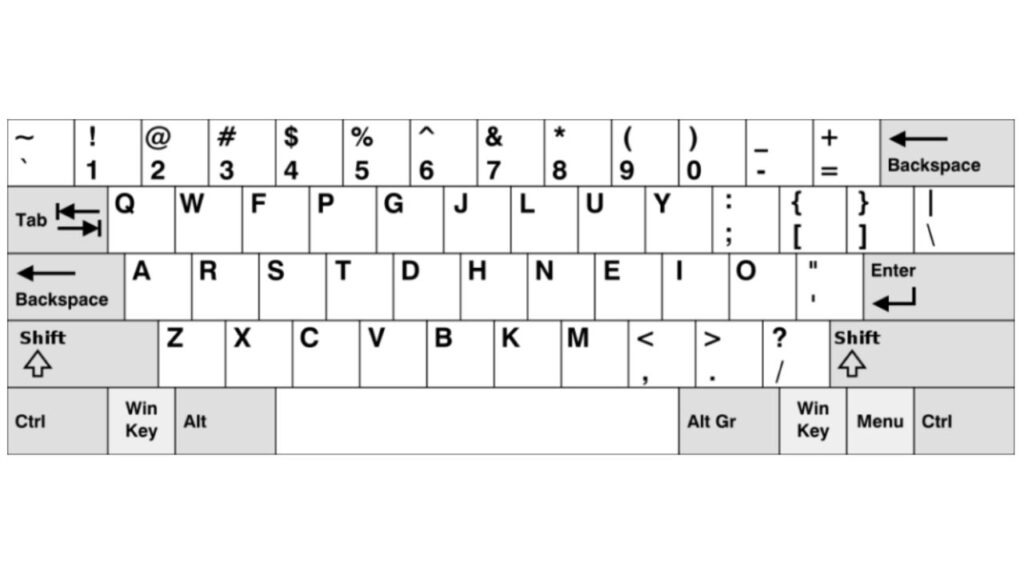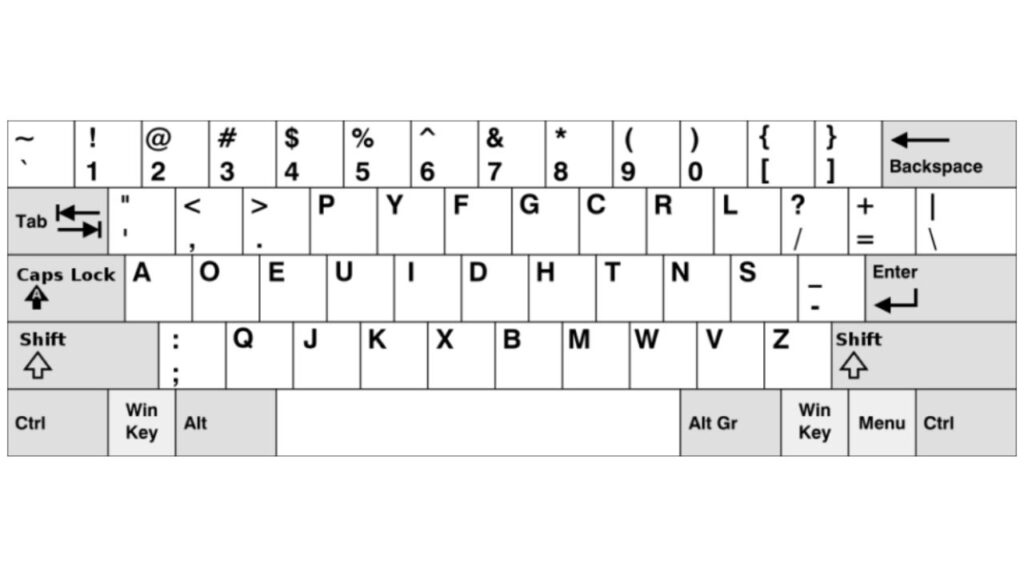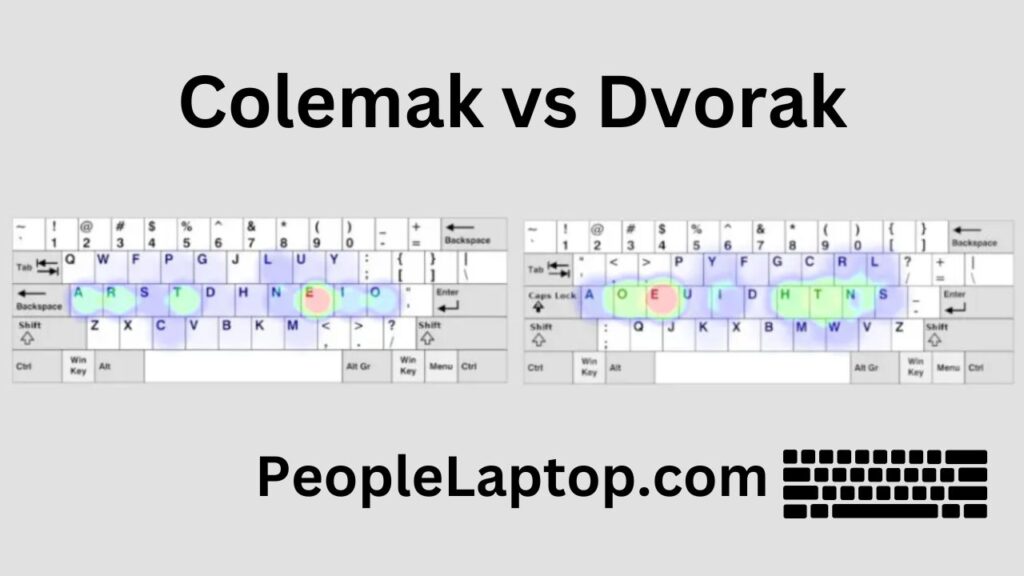In the realm of the digital age, where our fingers fly across keyboards weaving words into existence, a silent war rages on. A war not of pixels and polygons but of key placements and finger acrobatics.
This, my friends, is the epic clash of Colemak vs Dvorak, two alternative keyboard layouts vying for the title of typing nirvana.
Both Dvorak and Colemak were born from the same frustration: the inefficiency of the ubiquitous QWERTY layout.
Invented in the 1870s for mechanical typewriters, QWERTY prioritized speed of production over typing ease. The result? A jumbled mess that leaves fingers contorting and minds boggled.
Enter Dvorak, the brainchild of August Dvorak in the 1930s. This layout places common letters on the home row and alternates hands for frequent bigrams, reducing finger travel and strain.
Dvorak boasts impressive speed gains, with studies showing up to a 40% increase in typing efficiency.
In this article, we’ll explore the key differences between Colemak and Dvorak, their design philosophies, and the pros and cons of each.
What is a Colemak layout?
Stepping into the spotlight as the second focus of this article is Colemak, an intriguing keyboard layout with roots in the Dvorak concept. This layout, conceived by Shai Coleman in 2006, stands as a younger contender compared to both Dvorak and the traditional QWERTY.

Colemak, born from the fusion of favorable aspects from QWERTY and Dvorak, represents an effort to refine and enhance typing efficiency.
The layout seeks to draw from the strengths of its predecessors while introducing improvements to create an optimal typing experience. In the historical context, its emergence in 2006 positions Colemak as a relatively recent addition to the keyboard layout scene.
Designed to outshine both QWERTY and Dvorak in terms of typing efficiency, Colemak takes the best elements from each and refines them. Its creator, Shai Coleman, envisioned a layout that amalgamates the positive attributes of traditional layouts while introducing enhancements for an improved typing experience.
While the efficacy of the Colemak layout will be explored further in this article, its youthfulness in comparison to Dvorak and QWERTY serves as a testament to its innovative approach to keyboard design.
For a more in-depth exploration of Colemak’s advantages and features, a dedicated article is available for readers seeking a comprehensive understanding of this modern keyboard layout.
What is a Dvorak layout?
We are addressing the fundamental query – what characterizes this keyboard layout? Dr. August Dvorak conceived it in the 1930s, offering an alternative to the well-established QWERTY layout. History lesson.

Significantly, the Dvorak layout emerged with the explicit goal of surpassing QWERTY in providing an enhanced typing experience. The vision was clear – to design a superior keyboard layout. However, it’s worth noting that this layout has a significant vintage, originating in the 1930s.
The Dvorak layout stands as a testament to its objective, aiming for greater efficiency compared to QWERTY. Dr. August Dvorak strategically minimized finger movement during typing, particularly by placing the majority of commonly used keys on the home row. This design choice translates into a more ergonomic and streamlined typing experience.
While acknowledging the virtues of the Dvorak layout, it is crucial to recognize that it has its challenges. Drawing from personal experience, it’s apparent that there are certain challenges associated with this layout.
Nonetheless, these challenges are navigable with relative ease. Despite its imperfections, the Dvorak layout unquestionably offers a superior typing experience when compared to the conventional QWERTY layout.
What is the difference between Dvorak and Colemak?
Both Dvorak and Colemak are alternative keyboard layouts designed to be more efficient and ergonomic than the traditional QWERTY layout. However, some key differences between them might make one a better fit for you than the other.
Here’s a table summarizing the key differences:
| Feature | Dvorak | Colemak |
| Optimization for English | High | Moderate |
| Learning curve | Steep | Moderate |
| Compatibility | Limited | Wide |
| Punctuation placement | Less convenient | Mostly QWERTY-like |
Dvorak keyboard layout
The timing measurements exhibit inconsistencies and demonstrate a bias towards QWERTY.
In our assessment, we arrive at the following verdict: the Dvorak layout proves to be the most efficient as it demands the least effort for typing a given text, even though it may consume a similar amount of time as the QWERTY layout.
Colemak keyboard layout
But the story doesn’t end there. In 2006, Shai Coleman entered the fray with Colemak.
Inspired by Dvorak but taking a different approach, Colemak retains some QWERTY familiarity while optimizing for efficiency.
Common letters like S, T, E, and I reside on the home row, and punctuation remains largely unchanged.
So, which layout reigns supreme? The answer, like most things in life, is that it depends. Here’s a breakdown of their strengths and weaknesses:
Background: The Need for Change
The QWERTY keyboard, invented in the 19th century, was designed to prevent mechanical typewriters from jamming. However, it needs to be optimized for the needs of modern computer users.
This realization has given rise to alternative layouts like Colemak and Dvorak, both aiming to enhance typing speed, reduce finger strain, and improve overall comfort.
Dvorak Simplified Keyboard: The Pioneer
Developed by Dr. August Dvorak and his brother-in-law, Dr. William Dealey, in the 1930s, the Dvorak Simplified Keyboard was one of the earliest attempts to create a more efficient typing layout.
Dvorak aimed to minimize finger movement by placing the most common letters and letter combinations under the strongest and most easily accessible fingers.
Pros of Dvorak:
- Reduced finger movement and strain.
- A focus on placing commonly used letters on the home row.
- Designed to increase typing speed and accuracy over time. It can improve ergonomics and reduce typing fatigue.
- Highly optimized for English, with common letters and bigrams on the home row.
- Significant speed gains for dedicated users.
Cons of Dvorak:
- The steeper learning curve for users accustomed to QWERTY.
- Limited compatibility with existing software and online platforms.
- Punctuation placement can be awkward for some users.
Colemak: A Modern Approach
Colemak, designed by Shai Coleman in 2006, takes a different approach to optimizing the layout.
It aims to strike a balance between improving efficiency and making the transition from QWERTY smoother for users.
Colemak retains some QWERTY positions to ease the learning curve while repositioning other keys for improved finger movement.
Pros of Colemak:
- Easier transition for QWERTY users.
- Reduced finger movement compared to QWERTY.
- Broader support on operating systems and devices.
- Good balance between speed and ease of transition.
- Punctuation placement remains mostly unchanged.
Cons of Colemak:
- Dvorak is more optimized for finger placement.
- Dvorak is more optimized for English, leading to slightly less speed gains.
- Some key placements might feel awkward for QWERTY users.
- Smaller community compared to Dvorak.
Learning Curve and Adaptability
One of the significant challenges when transitioning to an alternative keyboard layout is the learning curve.
Dvorak’s radical departure from QWERTY can be intimidating for some users, making the initial adaptation period longer.
On the other hand, Colemak’s approach to preserving some QWERTY positions allows for a more gradual and manageable learning curve.
Community and Support
Both Colemak and Dvorak have passionate communities that provide support, resources, and tools for users making the switch.
However, Colemak has gained more popularity in recent years, leading to better integration and support across various platforms.
Conclusion:
Choosing between Colemak and Dvorak ultimately depends on personal preference, typing habits, and the willingness to invest time in learning a new layout.
While Dvorak may offer a more optimized arrangement for finger movement, Colemak provides a smoother transition for those not ready to make a radical shift.
Whichever layout one chooses, the goal remains the same: to enhance typing comfort, speed, and overall efficiency in the digital age. Comment here.

